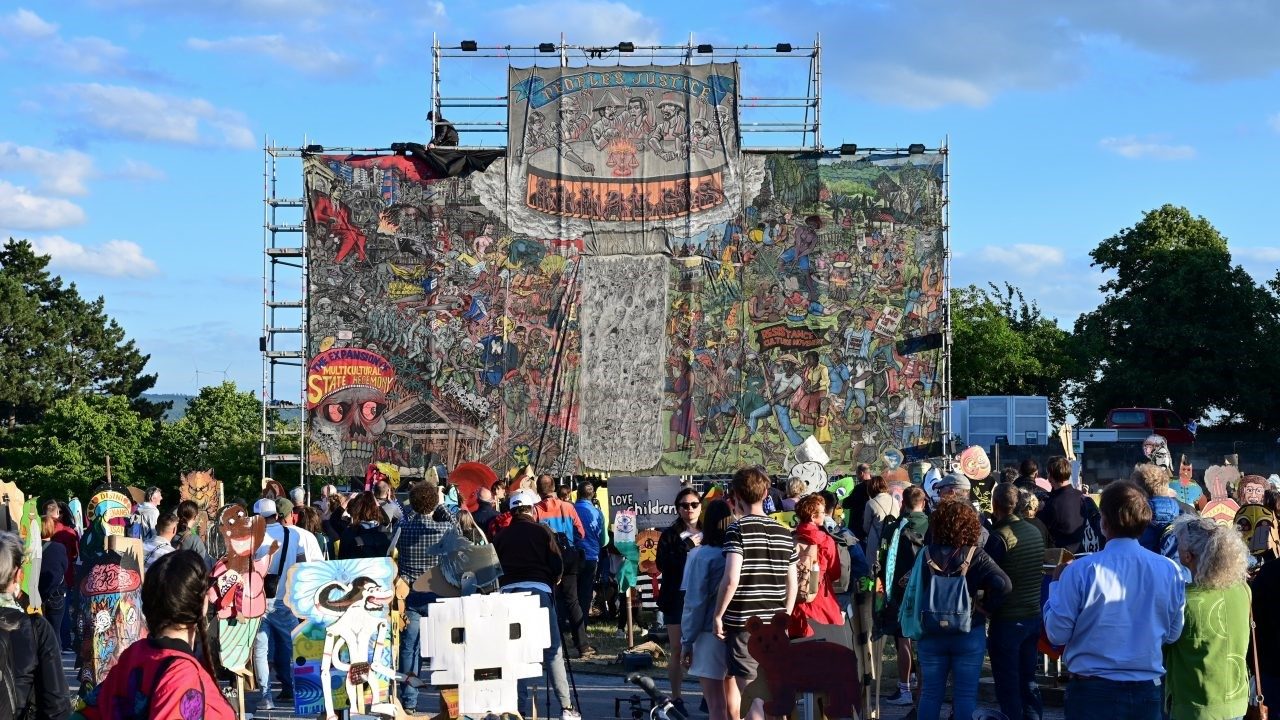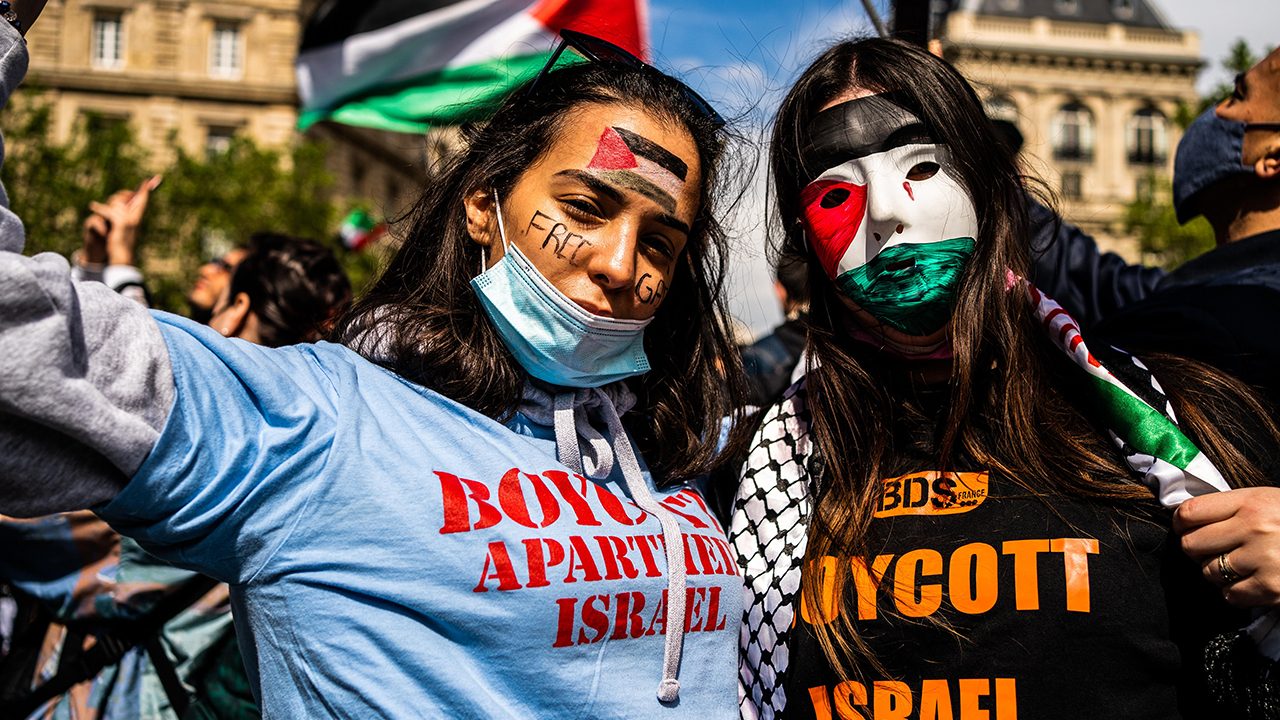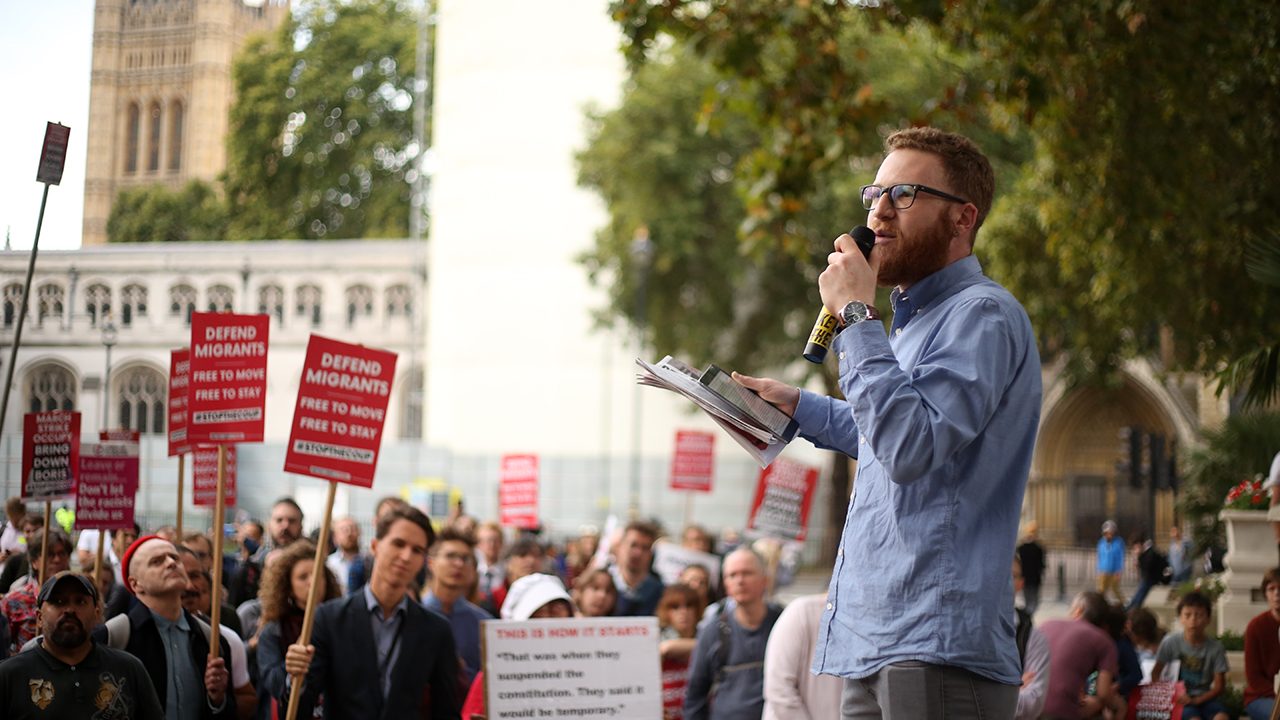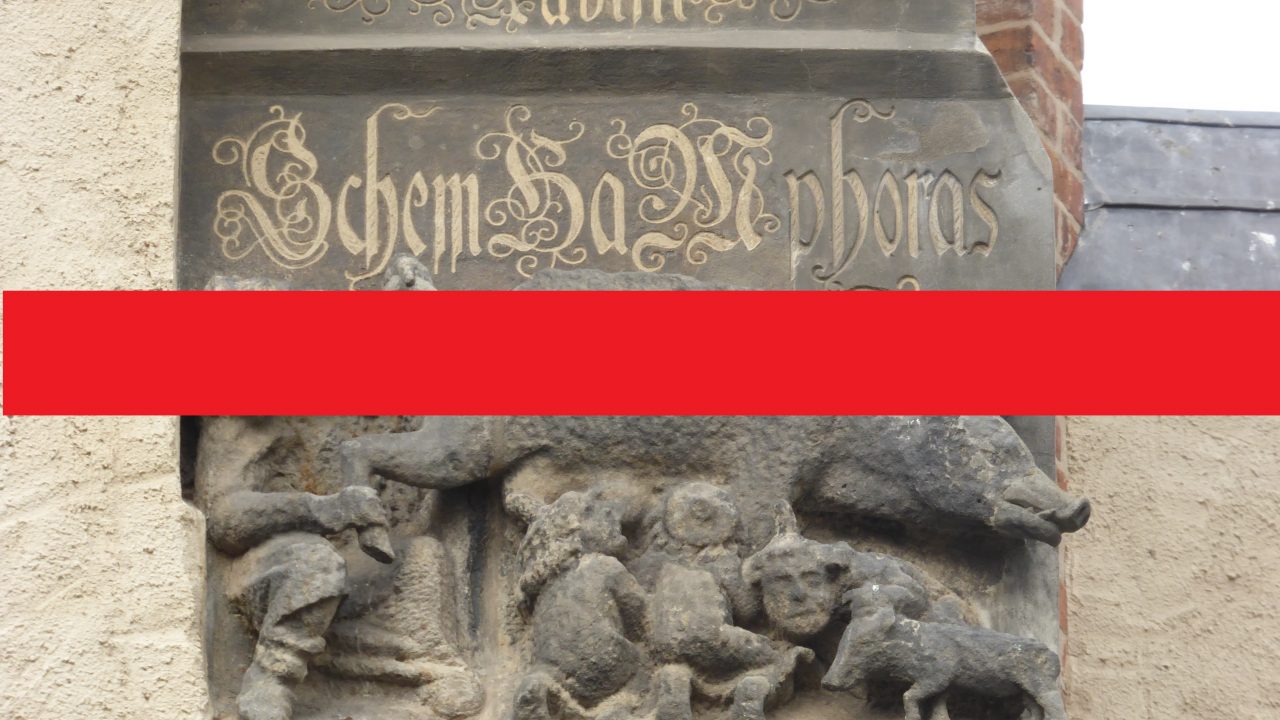
With antisemitism on full display at documenta 15, which got underway this weekend, the cringe factor is already off the charts and increasing by the hour.
Since documenta announced the addition of the Indonesian artist collective ruangrupa to its roster of curators, voices have been warning about antisemitism being dressed up as art at Germany’s most-visited major exhibition of international art. The Central Council of Jews in Germany, for example, criticised the fact that ruangrupa invited a Palestinian collective containing members that work for an organisation said to be named after a Hitler loyalist from the 1930s. There are also reports that documenta is affiliated with groups supporting the cultural boycott of Israel (according to Tagesspiegel). In May 2022, the Central Council realised documenta was likely in support of this boycott given that not a single Israeli artist had been invited to participate in the event (according to Tagesspiegel). This failed to receive much attention either from documenta’s management team or the arts pages of Germany’s media outlets, not least because the idea behind appointing ruangrupa was to put an end to the exhibition’s Eurocentric focus once and for all.
The principle of hope over contention: a failed attempt
Eurocentrism means a cultural world view centred on the northern hemisphere and particularly on Europe and North America. The desire expressed by the organisers of documenta is to look beyond the north and give the “Global South” the representation it deserves. In principle, this is a cause worth supporting, not to mention a potentially exciting one. However, in appealing to the freedom of art and of artists’ collectives, the documenta organisers missed opportunities prior to the exhibition to address artistic representations of group-focused enmity, in particular manifestations of antisemitism. Their defence? “We don’t even know what the artists are planning to show yet”. Theirs was a principle of hope instead of an attempt to highlight democratic values and the limits of expression – the grey area where people are belittled, dehumanised and abused on the basis of an identity prescribed to them, or where they are denied the very right to exist.
One would think this constituted sufficient grounds for a debate – or even to set boundaries in advance. The organisers invited multiple artists supportive of BDS who, at best, are vocal about a boycott of Israel and, at worst, call the country’s entire right to existence into question. The Jewish community made it clear ahead of time that not all BDS supporters are antisemitic, but that due to the presence of BDS they no longer felt safe in an environment where such claims are openly accepted. It is clear that those in charge of documenta hoped these artists would refrain from expressing their antisemitic tendencies in their art, allowing the entire debate to be sidestepped on how acceptable it is for individuals to advocate Israel being wiped off the map. It is often pointed out how unacceptable such appeals are in the country where National Socialism originated and the Holocaust was perpetrated. Quite honestly, though, anyone serious about establishing democracy and equality for all peoples should never accept such demands, regardless of where they are in the world.
Pure, unvarnished antisemitism
We no longer need to spend time speculating on how antisemitic documenta 15 will be, as the event was inaugurated on the weekend of 18 and 19 June 2022. Sadly, the exhibition and the responses to it draw parallels with a painting by German pop art artist Martin Kippenberger, which shows a partially deconstructed swastika and bears the charming name, “With the Best Will in the World, I Can’t See a Swastika”. At documenta 15, by contrast, the organisers – with the best will in the world – didn’t want to see antisemitism, despite the fact that one of the oldest stereotypes known to humankind was displayed on documenta’s massive central installation at Friedrichsplatz. Known as “People’s Justice”, the artwork was created by the Taring Padi artist collective from Indonesia. The work shows a Jew made to look like an animal, with a hook nose, side curls (payot), bloodshot eyes and fang-like teeth, and dressed head to toe as a capitalist, with a cigar, bowler hat and suit with yellow lapels. The hat is emblazoned with SS runes to equate the figure’s actions with National Socialism and to highlight how the victim has transformed into the perpetrator. On another part of the installation is a soldier with the face of a pig. Written on his helmet is “Mossad” (the Israeli secret service), and he wears a scarf around his neck embroidered with the Star of David. This much can be said: this is about as explicitly antisemitic as can be. There is no room for interpretation. When a piece reproduces a style of caricature that appeared in the National Socialist newspaper “Der Stürmer”, this is not a metaphor – it is simply the truth. The question as to why this is permitted should have arisen, at the latest, when the work was installed (or, if the organisers had been smart, before documenta opened its doors).
Ultimately, documenta 15 is a home for antisemitic artworks. The piece by Taring Padi may be the largest and most explicit example, but there are others in the exhibition, including Mohammed Al Hawajiri’s series “Guernica Gaza” at documenta site WH 22, which reconstructs Picasso’s “Guernica” to equate Israel’s actions with those of the Nazis and their allies during World War II. An installation by Hamja Ahsan advertises “Halal Fried Chicken”, below which a greeting of “Ramadan Mubarak” is displayed together with the message, “Taste of a Liberated Palestine”.
It seems antisemitic posters or installations go hand in hand with artistic freedom. Of course, the artists have to endure the criticism that comes with such work – that is, unless the decision is made not to show it. Because it is a decision: should art embracing antisemitic stereotypes be rejected for its contemptuous treatment of people – or can it be exhibited despite this? In Kassel, age-old expressions of antisemitism are finding their way into the largest, most significant exhibition of modern (!) art in Germany. These antisemitic works are being put on a pedestal and thrust into the spotlight, enhancing their potency and allowing such stereotypes to be reproduced ad infinitum (including, sadly, in reports like this one).
documenta 15 decides in favour of acceptance of antisemitism
The documenta 15 organisers made the decision to show these artworks. Without comment, in the city centre, on a giant scale. And instead of standing by their antisemitism or their ignorance at the very least, the work by Taring Padi has now been “cloaked” by black cloths. By contrast, every sentence of the press release published in the wake of the act shows just how little the organisers understand the matter. There are references to how the “portrayal of figures” in the work have the potential “to be read in an antisemitic way”. It would be interesting to find out just how documenta and/or the artist collective responsible for the work might read SS globalist Jews and Mossad soldiers with pig faces in a non-antisemitic way.
Taring Padi, for its part, claims the work – which was created in 2002 – refers solely to the 32-year military dictatorship led by Suharto in Indonesia. According to the collective, people in Indonesia have used “popular symbols” to portray “the corrupt administration, the military generals and their soldiers, which are symbolised as pigs, dogs and rats as a means of criticising an exploitative capitalist system and military aggression”. Antisemitism is rife in Indonesia, which is home to “Third Reich restaurants” where visitors can take selfies with Hitler, where the Chinese are referred to in disparaging terms as “the Jews of Southeast Asia”, and where the fabricated “Protocols of the Elders of Zion” and the conspiracy ideology contained within continue to be studied under the guise of credible political literature (see tablemag.us). Following the opening of a Holocaust museum in North Sulawesi in February 2022, the vice president of Majelis Ulama Indonesia (MUI) – the Muslim Indonesian Ulema Council – stated that the museum was a “provocation” towards the country’s population and that it “ should be razed to the ground”. Furthermore, Indonesia maintains no diplomatic ties with Israel, because the country aligns itself with Palestine in the ongoing conflict in the Middle East (see Quantara.de).
What this means is that with antisemitism so widespread in Indonesia, the artists believe it only right to use a caricature of a Jew to embody a corrupt administration or an exploitative capitalist system. This was the same mindset adopted by the Nazis, who also liked to read the Protocols of the Elders of Zion. The pig-faced soldier marked as Jewish by the Star of David on his scarf embraces the image of the “Judensau”, or Jewish pig, a tradition that has existed since the middle ages – the public display of which rightly remains a topic of discourse today (see the “Judensau” verdict that was recently passed in Wittenberg, Germany: tagesschau.de). If a far-right party was to use these symbols on posters, it would be denounced as a most insidious and malicious expression of antisemitism. When an Indonesian artist collective does it? Well, it is still an incredibly insidious and malicious display of antisemitism. It is also worth pointing out that Indonesia has virtually no Jewish representation in its population, meaning such portrayals have zero chance of being grounded in anything other than antisemitic stereotypes.
Perceiving antisemitism as commonplace is all the more reason to object to it
The documenta press release goes on to provide its next threadbare argument: the work, it states, was made back in 2002 and has been displayed in Adelaide (Australia), Jakarta, Yogyakarta and Nanjing (China) without anyone having raised an objection. This is not a justification – it is a reason for worry and only serves to illustrate how little attention antisemitism receives and how it is not seen as a form of misanthropy.
The artist collective goes on to write that “Our work does not contain anything that seeks to represent any population groups in a negative light”. They are free to make this claim, but the reality is much different. Even if a person fails to call antisemitism by its name, an action – or a painting – can still be antisemitic. This is compounded by another audacious claim: “The figures, symbols, caricatures and other visual vocabulary in the works are specific to our culture and our own experiences”. As stated above, the depiction of the subject matter draws on antisemitic stereotypes that are rooted in Christian antisemitism and enriched with Islamic antisemitism. They absolutely do not have anything to do with the collective’s “own experiences” in Indonesia. The artists are now assuring the world that they never intended to be antisemitic and are “sad” that “the details in this banner have been understood in a way other than their original purpose”.
How enriching it would be to now have a discussion on what that original purpose was intended to be. If it was something like “antisemitism is so natural to us that we don’t think about it any more”, then this would perhaps constitute an opportunity to consider how they would feel if another section of the population – perhaps the very section to which they themselves belong – was to be portrayed as the embodiment of evil.
Instead, Taring Padi’s statement ends with the following statement: “The work will now stand as a monument of mourning to the impossibility of dialogue at this time. We hope this monument will now be able to prompt fresh dialogue”. If this is the case, then the ball is most definitely in their court – both the collective and documenta.
Even so, documenta is unable to bring itself to condemn the antisemitism in this work (and others) or even to refer to it as such. Instead, the general director of documenta und Museum Fridericianum gGmbH writes that artworks which are 20 years old and were created in the context of a political protest movement in Indonesia should not be “submitted for inspection”, and that the management regrets the fact that people’s “feelings were hurt” – as if acts of antisemitism, which continue to result in violent and even fatal attacks on people purely due to their being Jewish in Germany and the rest of the world, can be explained away as a “feeling” whose manifestations can be discussed like any other.
Evidently, the part of the German art scene represented by documenta is currently in no fit state to contribute anything meaningful to the debate on social values or to answer key questions about peace and coexistence in society. This is clear from documenta’s own ignorance of antisemitism, and from its argument that artists of the “Global South” need to be able to express “their own experiences”, even if these experiences are deeply racist, because they do not trust the artists to have the level of reflection required to recognise misanthropy in their works. The fact is that there are many artists worldwide who manage to be critical of society without stepping into the realm of antisemitism. Perhaps documenta should have given a platform to these artists. Still, they have until September 2022 to pursue that dialogue they so sorely desire.
Germany’s Federal Government Commissioner for Culture Claudia Roth (The Greens) responded to the scandal with a five-point plan and called for “structural reforms”. The minister criticised the organisers in a statement quoted by Der Spiegel: “The board and the collective of curators promised on multiple occasions that there would be no antisemitism at documenta. I trusted them. This trust was betrayed”. Roth states that she wants the federal government, which currently does not have “sufficient opportunity to participate”, to have more influence in future. Roth goes on to state that she would like the partners in the exhibition – namely the state of Hesse and the city of Kassel – to propose an “alternative” legal and organisational structure, calling for more international expertise and the “plurality of society in Germany, including the Central Council of Jews” to be part of this.
The ruangrupa curators have since apologised for the antisemitic mural: “This was our error. We apologise for the disappointment, shame, frustration, betrayal and shock that we caused to viewers”, states the collective on the documenta website. The Taring Padi mural was taken down on 21 June. While this was happening, demonstrators – many of whom were evidently artists – chanted anti-Israel and antisemitic slogans such as “From the river to the sea” (which denies Israel’s right to existence).
The scandal has led to one resignation, at least: Jörg Sperling, chairperson of the documenta forum (the exhibition’s circle of supporters), criticised the removal of the antisemitic artwork, stating in an interview that “A free world has to endure this”. The work by Taring Padi, Sperling states, is a caricature protected by artistic freedom which was removed “due to political pressure”. Sperling’s next comment illustrates how closely “criticism of Israel” is linked to antisemitism: “Art has raised an issue that lies beyond art: the relationship between Palestinians and Israelis. Art is unable to solve this problem, as is documenta”. In fact, “People’s Justice” has nothing to do with Israel.
The documenta forum responded to the statement and distanced itself from its chairperson.
Despite mounting pressure due to the antisemitism scandal, the general director of documenta 15, Sabine Schormann, is unwilling to step down. Schormann states that the priority is to clarify what led to this and “to bring the ship back on course. When the seas are rough, the captain doesn’t jump ship”. Schormann goes on to emphasise once again that it is not the management’s responsibility to check or approve the artworks ahead of time: “This is the remit of the art curators”. In view of the abundance of material on show, ruangrupa was “unfortunately unable to peruse every image, despite such a step being warranted given the sensitive issue of Antisemitism”. That may be so, but the fact remains that the triptych by Taring Padi was one of the main exhibits at documenta.


